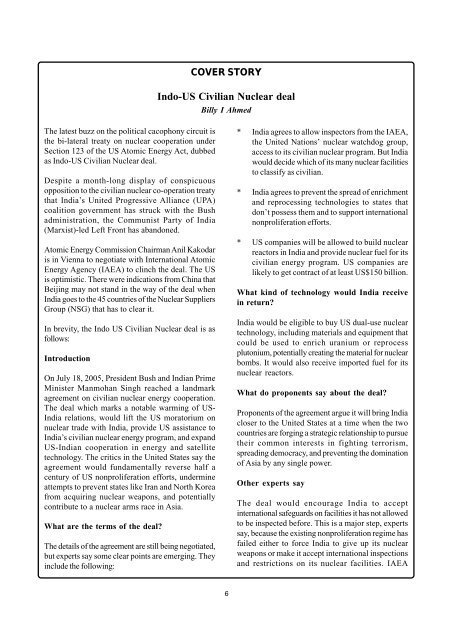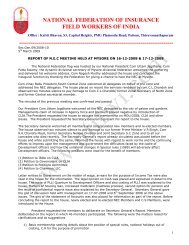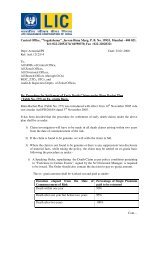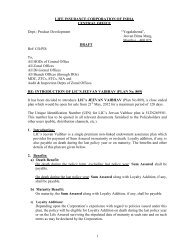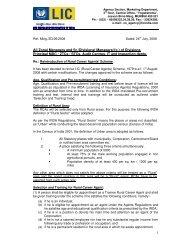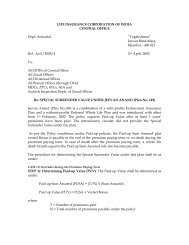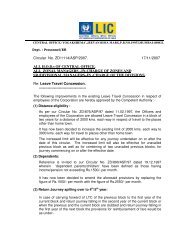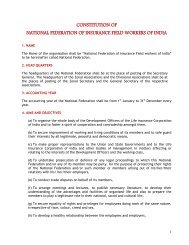news bulletin - NFIFWI
news bulletin - NFIFWI
news bulletin - NFIFWI
- No tags were found...
You also want an ePaper? Increase the reach of your titles
YUMPU automatically turns print PDFs into web optimized ePapers that Google loves.
COVER STORYIndo-US Civilian Nuclear dealBilly I AhmedThe latest buzz on the political cacophony circuit isthe bi-lateral treaty on nuclear cooperation underSection 123 of the US Atomic Energy Act, dubbedas Indo-US Civilian Nuclear deal.Despite a month-long display of conspicuousopposition to the civilian nuclear co-operation treatythat India’s United Progressive Alliance (UPA)coalition government has struck with the Bushadministration, the Communist Party of India(Marxist)-led Left Front has abandoned.Atomic Energy Commission Chairman Anil Kakodaris in Vienna to negotiate with International AtomicEnergy Agency (IAEA) to clinch the deal. The USis optimistic. There were indications from China thatBeijing may not stand in the way of the deal whenIndia goes to the 45 countries of the Nuclear SuppliersGroup (NSG) that has to clear it.In brevity, the Indo US Civilian Nuclear deal is asfollows:IntroductionOn July 18, 2005, President Bush and Indian PrimeMinister Manmohan Singh reached a landmarkagreement on civilian nuclear energy cooperation.The deal which marks a notable warming of US-India relations, would lift the US moratorium onnuclear trade with India, provide US assistance toIndia’s civilian nuclear energy program, and expandUS-Indian cooperation in energy and satellitetechnology. The critics in the United States say theagreement would fundamentally reverse half acentury of US nonproliferation efforts, undermineattempts to prevent states like Iran and North Koreafrom acquiring nuclear weapons, and potentiallycontribute to a nuclear arms race in Asia.What are the terms of the deal?The details of the agreement are still being negotiated,but experts say some clear points are emerging. Theyinclude the following:* India agrees to allow inspectors from the IAEA,the United Nations’ nuclear watchdog group,access to its civilian nuclear program. But Indiawould decide which of its many nuclear facilitiesto classify as civilian.* India agrees to prevent the spread of enrichmentand reprocessing technologies to states thatdon’t possess them and to support internationalnonproliferation efforts.* US companies will be allowed to build nuclearreactors in India and provide nuclear fuel for itscivilian energy program. US companies arelikely to get contract of at least US$150 billion.What kind of technology would India receivein return?India would be eligible to buy US dual-use nucleartechnology, including materials and equipment thatcould be used to enrich uranium or reprocessplutonium, potentially creating the material for nuclearbombs. It would also receive imported fuel for itsnuclear reactors.What do proponents say about the deal?Proponents of the agreement argue it will bring Indiacloser to the United States at a time when the twocountries are forging a strategic relationship to pursuetheir common interests in fighting terrorism,spreading democracy, and preventing the dominationof Asia by any single power.Other experts sayThe deal would encourage India to acceptinternational safeguards on facilities it has not allowedto be inspected before. This is a major step, expertssay, because the existing nonproliferation regime hasfailed either to force India to give up its nuclearweapons or make it accept international inspectionsand restrictions on its nuclear facilities. IAEA6


